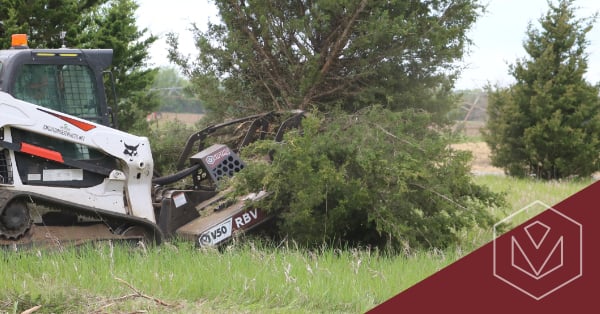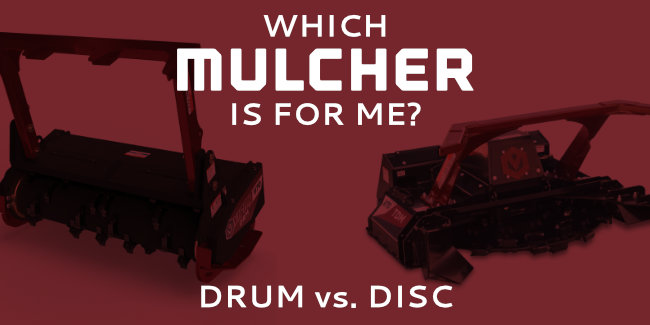
Choosing the right mulcher can make all the difference in land clearing projects. This comprehensive comparison of drum mulchers vs. disc mulchers will help you make an informed decision.
Drum vs. Disc Mulcher
Mulching is an essential process in land management and forestry operations, offering an efficient way to clear trees, brush, and overgrowth. When it comes to choosing the right mulching equipment, two popular options stand out: drum mulchers and disc mulchers.
Both mulcher attachments serve a similar purpose but have distinct features that make them suitable for different applications. In this article, we will explore the differences between drum mulchers and disc mulchers, helping you to make an educated choice based on your specific needs. 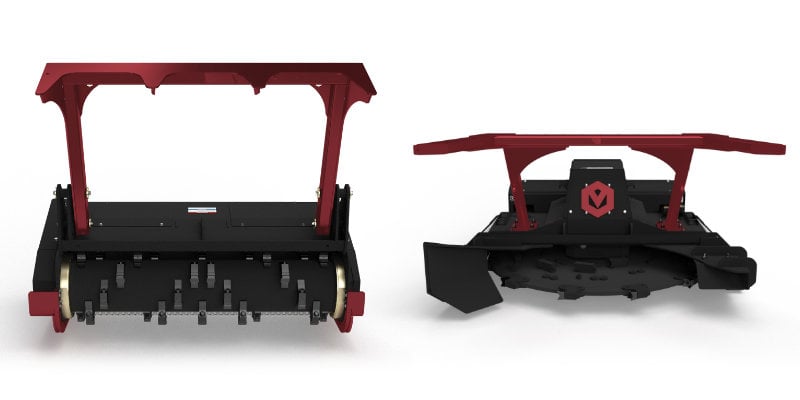 CHAPTERS (Click to skip to any section)
CHAPTERS (Click to skip to any section)
Drum Mulcher Advantages
Disc Mulcher Advantages
Virnig Drum vs. Disc Mulcher Comparison Chart
Comparing Performance & Efficiency
Productivity
Finish
Environment
Compatibility & Tuning
Common Specs
Special Considerations in Disc Mulchers vs. Drum Mulchers
Safety Requirements
Budget
Operator Experience & Preference
Drum Motor Options, Drum Styles, and Tooth Options
Disc Motor Options, Chute Styles, and Tooth Options
Maintenance and Wear Parts
Maintenance Requirements of Drum Mulchers
Maintenance Requirements of Disc Mulchers
Conclusion – Which Mulcher is Right For You?
Drum Mulcher ADVANTAGES
When a drum mulcher is operating, the rotating drum creates a powerful cutting action, effectively mulching vegetation in its path. The cutting teeth on the drum shred material into a fine mulch, which can be spread evenly across the ground.
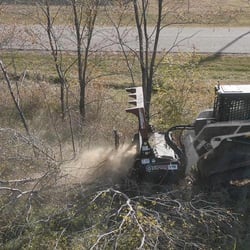 Drums are preferred in areas where flying debris is a concern, like residential environments. They leave a finely mulched finish during initial knockdown and are more productive at processing felled material. They're also able to grind stumps below ground level while providing a controlled cutting motion that directs most debris toward the ground.
Drums are preferred in areas where flying debris is a concern, like residential environments. They leave a finely mulched finish during initial knockdown and are more productive at processing felled material. They're also able to grind stumps below ground level while providing a controlled cutting motion that directs most debris toward the ground.
One key advantage of drum mulchers is they’re easier to operate than a disc, requiring minimal training for skilled operators. Visibility is excellent and a user can see when and where the drum engages material.
Disc Mulcher ADVANTAGES
Disc mulchers utilize a circular flywheel which spin at high speeds and effectively grind and mulch upon contact. The cutting teeth located on the top, bottom and perimeter of the disc help shred material.
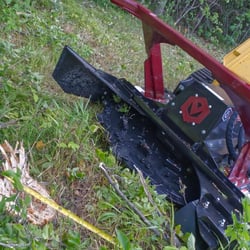 Due to their aggressive cutting design which relies on stored energy in the disc, disc mulchers are highly efficient at clearing land quickly. Disc mulchers can shred an entire tree within a second, and quickly recover speed to handle larger volumes of material in less time.
Due to their aggressive cutting design which relies on stored energy in the disc, disc mulchers are highly efficient at clearing land quickly. Disc mulchers can shred an entire tree within a second, and quickly recover speed to handle larger volumes of material in less time.
Disc mulchers generally have lower maintenance requirements compared to drum mulchers, leading to reduced downtime.
Drum VS. DISC Mulcher Comparison Chart
DRUM Mulcher |
DISC Mulcher |
Cutting Capacity |
|
| 14” Diameter Trees | 14” Diameter Trees |
Cutting Width |
|
| 60" & 72" | 60” |
Recommended Flow Rate |
|
| 30-50 GPM - High Flow Only | 30-45 GPM - High Flow Only |
Operating Techniques |
|
|
|
MATERIal Finish |
|
| Fine Initial Mulch, Smaller Wood Chips | Leaves Larger Wood Chunks & Branches - Reprocess for a Finer Finish |
DEBRIS CONTAINMENT |
|
| Excellent, Throws Most Material Downward in Controlled Motion | Unpredictable, Will Throw Material Away From the Mulcher |
PUSH BAR |
|
| Fanged Bolt-On Push Bar Design to Help Guide Trees Away From Loader | Bolt-On Push Bar to Help Guide Trees into the Deck |
VISIBILITY |
|
| Operators Can See When Drum Engages Ground & Material, And With A Shallower Depth and Lower Profile vs. Disc Mulcher, A Drum Has A Slight Visibility Advantage | Operators Cannot See the Disc from the Cab and Must Rely on Experience, Feel, and Sound to Operate Effectively |
Maneuverability |
|
| Ideal for Use in Tight Spaces, Urban Areas, or Uneven Terrain. Weight Distribution is More Toward Loader, Giving a Lighter Feel Compared to a Disc | Tougher to Maneuver in Tight Spaces or Uneven Terrain. More Weight is Distributed Away From the Loader, so it Feels Heavier When up High Than a Similarly Sized Drum |
Stump grinding |
|
| Open Design Allows Quick & Easy Stump and Root Grinding, and Mulching of Other Below-Ground Vegetation | Will Grind Stumps to Ground Level or Slightly Below Grade |
Comparing Mulcher Performance & Efficiency
When evaluating drum mulchers vs. disc mulchers, many factors should be considered. From cutting power and speed, to suitability for different terrains, all can shape your decision on the best mulcher for your specific needs.
Productivity  Efficiency is a critical factor to consider, as it directly impacts your productivity and time management. Disc mulchers are more efficient than drums, especially when mulching 4-8” diameter trees and dense vegetation. They have the ability to fully process a whole tree in a split second.
Efficiency is a critical factor to consider, as it directly impacts your productivity and time management. Disc mulchers are more efficient than drums, especially when mulching 4-8” diameter trees and dense vegetation. They have the ability to fully process a whole tree in a split second.
Finish
Although disc mulchers process material quickly, they leave behind large chunks of wood which may require reprocessing, back dragging or further site clean-up. Drum mulchers leave behind a finely shredded mulch and make up for a slower pace with a finer finish during initial knock down.
Environment
Drum mulchers are considered safer for use in urban areas, as they direct most debris downward and create a finely mulched wood chips. This means a more controlled cutting process and greater directional precision. Disc mulchers are better suited for rural environments, as they will throw large chunks of wood in a much less predictable manner, often at greater distances.
Regardless of the location of operation, we recommend bystanders to maintain a safe distance of at least 300 feet from a mulcher to prevent injury.
For ground mulching and stump grinding, drum mulchers have an advantage. A disc can grind stumps down to ground level, leaving roots intact. The cutting disc is typically held at an angle, allowing it to cut through wood while trying to avoid cutting into soil. Teeth can dull quickly, and the disc is only able to mulch slightly below grade. Drums, in contrast, excel with large stumps and extensive root systems because they’re specifically designed for this purpose. The open design allows them to be more effective at grinding up to 2” below grade.
Compatibility & Tuning
This may seem obvious, but it’s essential to check compatibility between the mulcher and your loader. Check mulcher flow rate and loader capacity requirements and compare them to your skid steer specs. Compatibility issues can lead to poor performance, potential damage, downtime and possibly catastrophic failure.
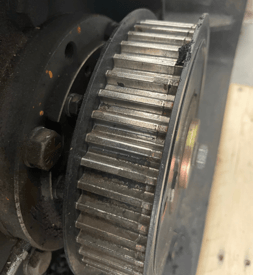
Drums are belt driven with two sheaves, a drum sheave and a motor sheave. Sheaves are essential in achieving optimal drum speed and come with varying tooth quantities. Each sheave combination is only compatible within a specific flow rate range, for example, 38-42 GPM. If there is a need to switch to a loader above the 38-42 GPM flow rate range, then a different combination of sheaves will have to be installed for optimal drum speed. If loader make and model are provided, then Virnig can tune the mulcher (with the right sheave combination) from the factory so it's ready to operate.
Competitor mulchers will need a motor displacement screw adjusted to the desired dimension measured with a caliper. Additionally, they’ll need to check the drum RPM with a tachometer after adjustment is completed. Each mulcher manufacturer provides their own guidelines and charts to assist with tuning the mulcher to the skid steer. Some drum mulchers come pre-tuned for use with a particular loader, while others require scheduling a technician to adjust the mulcher before use. Failure to do so may void the warranty.
Disc mulchers come ready to operate from the factory, with no tuning required. Discs are statically balanced, and are much easier to rebalance by simply adding or removing weights from the disc. They do not require expensive balancing equipment. Switching to a different loader brand or model only requires correctly sized hoses and couplers.
Drum Mulcher Common Specs
63-115cc piston motor | 60" & 72” cut widths | 15-20" drum | 2,000-2,500 RPM
Flow rate range: 30-50 GPM | 2800+ lb. recommended operating capacity
Virnig flow rate increments (GPM): 30-33.9, 34-37.9, 38-42, 42.1-45, 45.1-50
Virnig drum RPM: 2,350-2,500
Disc Mulcher Common Specs
125cc-160cc piston motor | 60" disc/cut width | 1,000 RPM max disc speed
Flow rate range: 30-45 GPM | 2,800+ lb recommended operating capacity
Virnig flow rate requirement (GPM): 30-45
Virnig disc RPM: 700-1,000
Special Considerations in Disc & Drum Mulchers
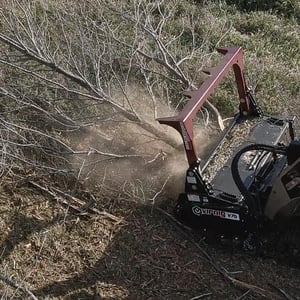 To make an informed decision on the most suitable mulching attachment for your specific needs, it’s important to consider safety, budget, operator experience, and additional options. By understanding the available choices and potential enhancements, you can better match your specific project requirements. Carefully weigh these factors, and you can confidently select the mulching solution that not only meets your needs but also ensures a smooth, productive, and safe operation.
To make an informed decision on the most suitable mulching attachment for your specific needs, it’s important to consider safety, budget, operator experience, and additional options. By understanding the available choices and potential enhancements, you can better match your specific project requirements. Carefully weigh these factors, and you can confidently select the mulching solution that not only meets your needs but also ensures a smooth, productive, and safe operation.
Safety Requirements
Safety should always be a top priority when operating heavy machinery. Look for forestry mulchers that prioritize operator safety by incorporating features such as shatterproof polycarbonate doors and cabs, hydraulic coolers and FOPS. Prioritizing safety will protect the operator and reduce the risk of accidents and equipment damage.
Because disc mulchers can throw larger material at greater distances, drums are considered safer in residential areas. However, both disc mulchers and drum mulchers can cause debris, rocks, and wood chips to ricochet toward the loader and operator. For operator safety, all mulcher manufacturers require shatterproof cabs to be installed. Some also advise using a falling object protection system (FOPS).
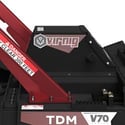 Another safety consideration is protecting the attachment itself. Motor guards, spindle guards, and pressure relief valves help protect your investment for long-term heavy use.
Another safety consideration is protecting the attachment itself. Motor guards, spindle guards, and pressure relief valves help protect your investment for long-term heavy use.
Budget
Drum mulchers have a much higher upfront cost, and options like bite control, carbide teeth, pressure gauge and/or hydraulic doors quickly add to the initial expense. They have more moving parts than disc mulchers and tend to be more expensive and difficult to maintain. However, their are less teeth and they're are easier to sharpen and replace on a drum than a disc.
Operator Experience & Preference
Disc mulchers require a higher degree of skill and experience to operate effectively. It may take time to learn advanced techniques, especially cutting and guiding trees into the chute for immediate processing.
 Drum mulchers require minimal training for skilled operators and offer an optional pressure gauge which is beneficial for novice operators. It helps prevent both underloading and overloading the hydraulic system. It’s especially advantageous while grinding stumps, as it’s easier to monitor the gauge while the loader isn’t moving.
Drum mulchers require minimal training for skilled operators and offer an optional pressure gauge which is beneficial for novice operators. It helps prevent both underloading and overloading the hydraulic system. It’s especially advantageous while grinding stumps, as it’s easier to monitor the gauge while the loader isn’t moving.
Both drum mulchers and disc mulchers will require an experienced operator. That said, drums are generally easier to operate because they offer better visibility, greater maneuverability, and simpler cutting methods.
Drum Mulcher Motor Options, Drum Styles, Tooth Options
There are two bent-axis piston motor options for drums: fixed displacement and variable displacement. A fixed motor is less expensive and provides one speed at max torque. A variable motor operates at two different speeds and torque levels. Variable motors automatically reduce speed in dense vegetation for more torque and back to a higher speed in lighter vegetation. Variable motors are favored for their productivity gains and lower susceptibility to stalling.
There are two primary drum options available: smooth or bite control. Although smooth drums are more common, bite control drums are better suited for beginner operators and processing larger trees and vegetation. Smooth drums tend to throw larger material and can grab and pull themselves into stumps and other material more easily, which increases the chances of stalling the drum. In contrast, bite control regulates the amount of material the drum can bite off, helps maintain rotor speed, and provides a more consistent wood chip size. Steel teeth are preferred on bite control drums, as carbide teeth are not as effective with them. Bite control drums are more expensive than smooth drums.
Most operators start with carbide teeth on a smooth drum, unless running a bite control drum where they’d use steel. Carbide is often replaced with steel planers since they’re cheaper and more productive. Operators can mix and match tooth styles as long as the same tooth is installed on the opposing sides of the drum. Some operators install steel in the middle of the drum since that’s where most of the mulching production occurs, and use carbide on the outside for less maintenance. The outside of the drum is more likely to contact rocks and other debris, which carbide can resist better than steel.

Disc Mulcher Motor Options, Chute Styles, Tooth Options
Some disc mulcher manufacturers may offer a gear motor as a cheaper option, but this will result in lower performance. Bent-axis piston motors with fixed displacement are the most common and are generally preferred, as they offer the best productivity and performance. A piston motor provides more torque, faster recovery time and the loader’s hydraulic system runs cooler.
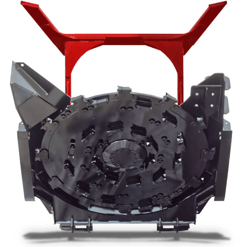 The best option for a disc is a fully machined, perfectly balanced disc with bolt-on tooth mounts and bolt-on teeth. These bolt-on tooth mounts and bolt-on teeth make for a much easier rotation or replacement process versus welded-on replacement parts.
The best option for a disc is a fully machined, perfectly balanced disc with bolt-on tooth mounts and bolt-on teeth. These bolt-on tooth mounts and bolt-on teeth make for a much easier rotation or replacement process versus welded-on replacement parts.
The disc mulcher is equipped with a standard tapered chute design which helps guide trees into the disc. The bottom edge drops below the disc to help scoop trees from the ground. We also offer an open chute option, which features more space between the chute and disc to process larger, bushy material. The bottom edge is flush with the disc, allowing easier stump grinding and mulching slightly below grade.
Virnig’s Tree Disc Mulcher comes standard with 4-point rotatable steel teeth, made from high-grade alloy steel and heat-treated for optimal performance. They’ll need to be sharpened and rotated regularly to maintain cutting performance. We also offer carbide teeth as an option, with a sharp and aggressive cutting angle for productive mulching. Carbide teeth are low maintenance, with no sharpening required, and are ideal for rocky or sandy environments. The teeth are sourced from Quadco® which means proven performance and they'll last and hold their cutting edge longer.
Mulcher Maintenance and Wear Parts
Investing in a forestry mulcher that offers durability and ease of maintenance is essential for long-term cost-effectiveness. Evaluate the construction quality, material durability, and overall reliability of the mulcher. Additionally, consider factors such as accessibility for routine maintenance, availability of spare parts, and manufacturer warranties to ensure a smooth and hassle-free ownership experience.
Maintenance Requirements of Drum Mulchers
With more parts that are generally more expensive and difficult to maintain, drum mulchers have a higher operating cost. For example, there's a wear liner, two bearings, sheaves and a timing belt which don't exist on a disc mulcher. The drum bearings must be greased often and bearing spindle oil level must be checked periodically as well. If options like a pressure gauge and hydraulic door are added, maintenance costs may rise.
Drums are dynamically balanced, and vibration is measured while spinning using specialized balancing equipment. Balancing involves identifying any unbalanced forces by determining their weight and location, followed by adding or removing weights in a particular pattern for counterbalance. A 3 ounce weight difference can create enough vibration in the cab to make the mulcher inoperable. Compared to disc mulchers, rebalancing a drum is considerably more challenging and requires an expensive balancing kit or a third-party balancing service.
Maintenance Requirements of Disc Mulchers
With fewer moving parts it’s generally less expensive and easier to maintain disc mulchers compared to drum mulchers. The most common replacement parts are the teeth, and Virnig offers a variety of tooth kit options for both steel and carbide teeth. These kits include all required hardware to quickly and easily replace worn teeth, with no welding necessary! Also, the holders are bolted to the disc and are simple to replace unlike a drum where the holders are welded to the drum rotor.
Efficient drum and disc mulcher performance relies on well-maintained and functioning wear parts. Operators should be able to swiftly inspect, clean, and replace when necessary. Minimize downtime and maximize productivity by paying attention to these wear parts and knowing when to rotate or replace. Replacement parts should be easily accessible and readily available.
Conclusion - Which mulcher is right for you?
Both drum and disc mulchers excel in certain environments, so the ultimate answer to the Drum Mulcher vs. Disc Mulcher debate is whichever is best suited for you and your customers.
 Disc mulchers are faster and excel at mulching large trees and dense vegetation, processing entire trees within seconds. However, their cutting action is less predictable and they tend to throw larger wood chunks, making them more suitable for rural areas.
Disc mulchers are faster and excel at mulching large trees and dense vegetation, processing entire trees within seconds. However, their cutting action is less predictable and they tend to throw larger wood chunks, making them more suitable for rural areas.
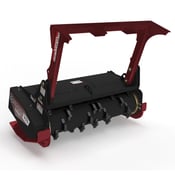 Drum mulchers operate at a slower pace but produce a finer mulch. They are capable of grinding stumps below ground level and offer a controlled cutting action which directs most of the mulch downward. Drum mulchers are considered safer for use in urban areas and alongside roads.
Drum mulchers operate at a slower pace but produce a finer mulch. They are capable of grinding stumps below ground level and offer a controlled cutting action which directs most of the mulch downward. Drum mulchers are considered safer for use in urban areas and alongside roads.
Each type of mulcher has its own distinct advantages, so the more you know about your specific needs for job sites the more informed decision you can make. We hope this guide has been helpful in evaluating cutting power, efficiency, durability, and safety. You should now be equipped with the knowledge necessary to choose the best forestry mulcher that meets your business needs, enhances productivity, and ensures long-term value for your investment.
If you’d like to discuss more about Virnig’s V70 Drum Mulcher or the V70 Disc Mulcher, please give our attachment experts a call at 800-648-2408.
If you’re ready to purchase your new mulcher attachment, find a Virnig dealer near you to check pricing and availability.
For a more general outline on drum vs. disc mulchers, be sure to check out this post from 2021 where we discuss cost, performance, and a few other differences.
If you’re interested in more information about Virnig brush cutters, don’t miss out on The Ultimate Guide to Skid Steer Brush Cutters. This comprehensive resource is brimming with valuable insights and practical advice to help you maximize the potential of your brush cutter.
